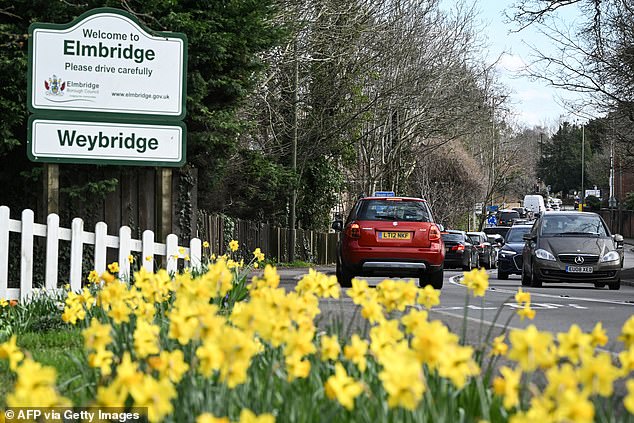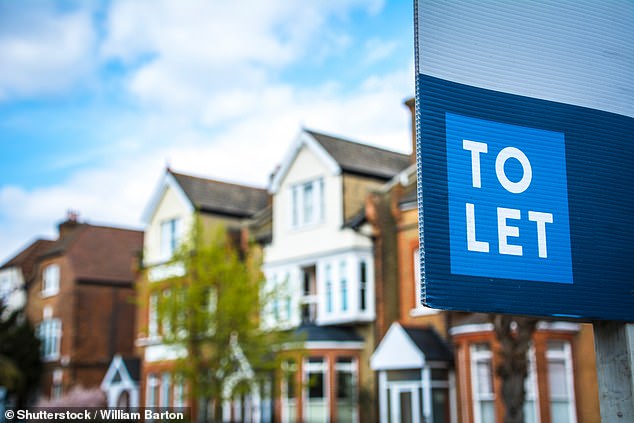Tenants are prioritising the ease of commuting once again as they look for a new home, according to new data from Savills.
The estate agent said this was reflected in its latest data revealing popular commuter areas with the strongest rental growth.
These areas with the best growth in the first three months of this year include Chester, Birmingham, Cobham and Weybridge, which saw values rise 3.9 per cent, 3 per cent and 2 per cent respectively.

Areas with biggest rent rises include Weybridge, where values have increased 2 per cent in the past three months
It is in sharp contrast to the start of the pandemic four years ago when lockdowns prompted a ‘race for space’ in the property market as people flocked to the countryside and coastal areas.
As people return to the office, Savills said tenants are prioritizing the ease of their commute when choosing a new place to live.
The appeal of commuter belt spots such as Cobham and Weybridge is the ability to enjoy surrounding countryside combined with the amenities of a vibrant town and good transport links.
The train station in Weybridge provides train services into central London that are less than half an hour.

Areas with biggest rent rises include the city of Chester, where values have increased 3.9 per cent in the past three months
Savills said urban areas generally continue to outperform their surrounding areas, with regional towns and cities growing by 8.2 per cent on the year compared to 2.3 per cent growth in surrounding areas.
Built-up areas in London’s commuter belt are also outperforming at 3.9 per cent compared to 1.5 per cent for more rural commuter belt locations.
Harriet Scanlan, of Richmond estate agency Antony Roberts, said: ‘Despite a slight increase in properties available to rent in areas popular with commuters such as our part of London, this hasn’t translated into cheaper rents.
‘Tenants are presented with a wider array of choices, leading to an increase in viewings per property, yet landlords continue to benefit from steady rental incomes and minimal-to-no void periods.
‘However, it’s important to note while the modest increase in available properties to rent is encouraging, it’s not yet sufficient to tip the scales in favour of renters. Supply continues to lag behind demand, ensuring that rental prices remain robust.’
| Q1 2024 | Suburban | Inner Commuter | Outer Commuter | Regional towns & cities | Cotswolds & South West | All Regional Offices |
|---|---|---|---|---|---|---|
| Quarterly growth | 0.90% | 0.70% | 0.80% | 0.90% | 0.50% | 0.90% |
| Quarterly growth, Q4 2023 | -0.30% | 0.30% | 0.60% | -0.60% | -0.80% | -0.20% |
| Annual growth | 4.20% | 2.20% | 3.60% | 7.40% | 3.30% | 4.00% |
| Growth since Mar-20 | 21.10% | 24.30% | 24.70% | 26.90% | 26.20% | 23.90% |
| Source: Savills | ||||||
Expensive areas in the heart of London are not seeing a similar rise in rental values.
They increased 0.3 per cent during the first three months of this year, with Savills attributing the slowing rental growth on the market ‘slipping back into a seasonal pattern’.
It means rental values have increased by 0.9 per cent in the past three months across affluent regions, while annual growth has slowed to 4 per cent.
However, Savills explained that rents still remain significantly higher, at 18 per cent, than before the start of the pandemic.
| Q1 2024 | Prime Central London | North West London | South West London | West London | North and East London | All prime London |
|---|---|---|---|---|---|---|
| Quarterly growth Q1 2024 | 0.50% | 0.60% | -0.10% | 1.10% | 0.00% | 0.30% |
| Quarterly growth Q4 2023 | -0.50% | 0.50% | -0.40% | 0.70% | 0.00% | -0.10% |
| Annual growth | 2.50% | 4.10% | 2.90% | 6.30% | 2.70% | 3.20% |
| Growth since March 2020 | 14.00% | 18.90% | 20.70% | 21.30% | 15.90% | 17.70% |
| Source: Savills |

Rents in regional towns and cities continue to outperform their surrounding areas, says Savills
Savills said Chester, Birmingham, Cobham and Weybridge are among the strongest performers this year, as tenants re-prioritise ease of commute.
Jessica Tomlinson, of Savills, said: ‘Rental growth picked up slightly on the quarter, however, affordability pressures and increased stock mean rental growth has settled at a much lower level compared with the last three years.
‘But rents remain at a record high, and the prospect of falling mortgage rates is expected to ease some of the financial burden on landlords.
‘Rental growth continues to exceed capital value growth, meaning that yields have improved across the sector, which will support continued investment.
‘In London, houses are now outperforming flats, signalling that the flats market maybe hitting an affordability ceiling, while tenants searching for houses typically have slightly more leeway when it comes to budget.
‘Also, a stronger sales market has constrained the number of houses to rent across the capital, particularly across west and north west London.’




